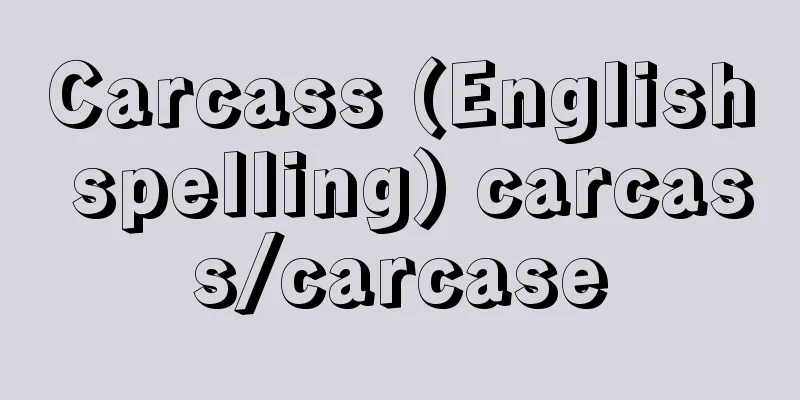Slime mold - Henkeikinrui

|
A general term for eukaryotic fungi that produce plasmodia without cell walls. In the past, they were also called myxomycetes or slime molds, including those that produce pseudoplasmodia, but cellular slime molds and labyrinthules, which produce pseudoplasmodia, are now excluded from this category because they have different evolutionary paths. The trophozoites are unicellular bodies (slime mold amoebae) that exhibit amoeboid movement, or plasmodia containing multiple nuclei. The zoospores that arise from the spores have a pair of two long and short flagella at the anterior end. [Hironori Terakawa] Biology and NutritionSome parasitize the roots of angiosperms or algae, but most are soil fungi that saprotrophically grow on rotting wood, fallen leaves, and humus. Some feed by ingesting granular organic matter and bacteria, while others, such as Physarum polycephalum, obtain nutrition by covering basidiomycete mushrooms with their plasmodium. The plasmodium stores glycogen and contains oil droplets and pigments. White and yellow are the most common colors, but there are also colorless ones and black, brown, purple, blue, green, red, orange, and more. [Hironori Terakawa] Organization and ReproductionSlime mold amoebae have a single nucleus and can be haploid or diploid. Haploid amoebae arise from spores or from detached flagella of zoospores. Haploid amoebae undergo division and conjugation, and in some cases become parasitic on fungi, forming haploid plasmodium. Diploid amoebae arise from zygotes and grow into diploid plasmodium. There are three types of microplasmodium (protoplasmodium), cryptoplasmodium, and cryptoplasmodium. The characteristics of slime molds are discussed below. (1) Dormancy When the environment becomes poor, plasmodium, especially ectophytic plasmodium, becomes irregularly dense and forms horny masses. These are called sclerotia (sclerotium), and when the environment becomes good, plasmodium will again be produced. Resting spores are formed from the plasmodium, and at that time, fruiting bodies are generally formed from the plasmodium, and spores are formed in the fruiting bodies. The dormant state of young, small plasmodium is called a macrocyst (large cyst), and in the case of slime mold amoebae, it is called a microcyst (small cyst). (2) Fruiting bodies Light, temperature, humidity, acidity, etc. are involved in the formation of fruiting bodies. Fruiting bodies vary in shape, color, and size, but there are naked fruiting bodies (class Dictyostelium) that produce vegetative spores externally on the surface of the fruiting body, and ectophytic fruiting bodies (class Myxomycetes) that produce true spores internally. The latter can be classified into two types: one in which a membrane is deposited on the surface of the plasmodium, which rises up to become a fruiting body (subclass Myxogastropods), and one in which the fruiting body develops from a mass of plasmodium on a membrane deposited on a substrate (subclass Myxogastropods). There are three types of fruiting bodies: plasmodia, nodular fruiting bodies, and stalked sporangia. Physodia retain the original branched plasmodia shape to some extent, dividing into net-like, pillow-like, or biscuit-like shapes, producing outer walls and harboring spores. Nodular fruiting bodies are clump-like, and in rare cases can measure over 20 centimeters in diameter. Stalked sporangia are 4.5-25 mm high, and can grow densely in the hundreds. Some of these sporangia contain structures such as columns and capillaries in addition to spores, and some have lime deposits. [Hironori Terakawa] ClassificationMyxomycetes are divided into four classes. The classes Myxomycetes, Myxoplasma, and Myxoplasma each contain one order, while the Myxomycetes contain four orders in the subclass Myxogastropods and one order in the subclass Myxomycetes. The presence or absence of micropilae in the sporangium and their characteristics are important in classification. [1] Aquatic Myxomycetes [2] Class Bacilliformes [3] Dictyostelium [4] Myxomycetes (2) Phyllostachys order: They form nodular fruiting bodies and other structures from protophytic or ectophytic plasmodium. They do not have fine capillaries. The spore walls have spines and nets. Phyllostachys and Phyllosporium form nodular fruiting bodies, and the stalked sporangium of Dictyostelium has a column axis. (3) Dictyostelium: The plasmodium intermediate between the shadow- and cytoplasmic plasmodium forms fruiting bodies with fine hairs. Dictyostelium and Dictyostelium form plasmoblastic fruiting bodies, while Chytridium nigricans forms stalked sporangia without a columnar axis. (4) Physarum polycephala: From the developed apical plasmodium, spores of sporangia generally measuring 0.5-1.7 mm in height are formed, with fine hairs. However, the yellow plasmodium of Dictyostelium discoideum creeps onto humus and plant matter, forming large nodular fruiting bodies. (b) Dictyostelium subclass [Hironori Terakawa] [References] | | | |Source: Shogakukan Encyclopedia Nipponica About Encyclopedia Nipponica Information | Legend |
|
真核菌類のうち、細胞壁のない変形体をつくるものの総称。以前は偽(ぎ)変形体をつくるものを含めて変形菌類または粘菌類ともいわれたが、偽変形体をつくる細胞粘菌類とラビリンチュラ類は、進化経路が異なるため現在はこれから除外される。栄養体はアメーバ運動を行う単細胞体(粘菌アメーバ)、または多核を含む変形体である。胞子から生じた遊走子には前端に長短2本1組の鞭毛(べんもう)がある。 [寺川博典] 生態と栄養被子植物類の根や藻類に寄生するものもあるが、多くは朽ち木・落ち葉、腐植質に腐生する土壌菌である。粒状有機物や細菌などを取り込んで捕食するもののほか、モジホコリカビ類のように担子菌類のキノコを変形体が覆って栄養をとるものもある。変形体内にはグリコーゲンを蓄え、油滴や色素をもっている。色は白と黄が一般的であるが、黒、褐色、紫、青、緑、赤、橙(だいだい)などのほか、無色のものもある。 [寺川博典] 体制と生殖粘菌アメーバは、単相または複相の一核をもつ。単相粘菌アメーバは胞子から生じるか、あるいは遊走子の鞭毛がとれてできる。単相粘菌アメーバは分裂と接合を行うほかに、菌によっては寄生して単相変形体となる。複相粘菌アメーバは接合子から生じ、成長して複相変形体になる。これには微小変形体(原生変形体)、陰生変形体、顕生変形体の三つの型がある。 以下、変形菌類の特徴に触れる。 (1)休眠体制 変形体、とくに顕生変形体は環境が悪くなると、不規則に密集して角質の塊になる。これは菌核(皮体)といわれ、環境がよくなると、また変形体を生ずる。変形体からは休眠胞子が形成されるが、そのとき一般に変形体から子実体が形成され、子実体に胞子が形成される。なお、若い、小さい変形体の休眠体制はマクロシスト(大包嚢(だいほうのう))とよばれ、粘菌アメーバの場合はミクロシスト(小包嚢)といわれる。 (2)子実体 子実体形成には、光、温度、湿度、酸度などが関係する。子実体の形、色、大きさはさまざまであるが、子実体の表面に栄養胞子を外生する裸実子実体(ツノホコリカビ綱)と、真正胞子を内生する被実子実体(胞子嚢)がある(変形菌綱)。後者には、変形体表面上に膜を堆積(たいせき)して盛り上がって子実体になる場合(変形腹菌亜綱)と、基物上に堆積した膜の上で塊になった変形体から子実体が発達する場合(ムラサキホコリカビ亜綱)がある。 被実子実体には変形子実体、団塊子実体、有柄(ゆうへい)胞子嚢群の三型がある。変形子実体はある程度もとの分岐した変形体の形を保って網状、枕(まくら)状、ビスケット形などに分断して外壁を生じ、胞子を内生する。団塊子実体は塊状で、まれに直径20センチメートル以上のものもある。有柄胞子嚢群は高さが4.5~25ミリメートルで、これが数百個密生する場合もある。この胞子嚢のなかには、胞子のほかに柱軸、細毛体などの構造をもつものもあり、石灰が堆積するものもある。 [寺川博典] 分類変形菌類は四綱に分けられる。水生変形菌綱、ネコブカビ綱、ツノホコリカビ綱は各一目を含み、変形菌綱は、変形腹菌亜綱の四目と、ムラサキホコリカビ亜綱の一目を含む。胞子嚢内の細毛体の有無とその特徴は、分類上重要視されるものである。 〔1〕水生変形菌綱 〔2〕ネコブカビ綱 〔3〕ツノホコリカビ綱 〔4〕変形菌綱 (2)クダホコリカビ目 原生変形体または顕生変形体から、団塊子実体その他を形成する。細毛体はない。胞子壁には刺(とげ)、網目などがある。クダホコリカビ、マメホコリカビは団塊子実体を形成し、アミホコリカビの有柄胞子嚢には柱軸がある。 (3)ケホコリカビ目 陰生変形体と顕生変形体の中間の変形体から、細毛体のある子実体を形成する。ケホコリカビ、ヌカホコリカビなどは変形子実体、ハイイロウツボカビは柱軸のない有柄胞子嚢群を形成する。 (4)モジホコリカビ目 発達した顕生変形体から、一般に高さが0.5~1.7ミリメートルの有柄胞子嚢群を形成し、細毛体がある。ただし、カワホコリカビの黄色の変形体は腐植土や植物体上にはいあがり、大きい団塊子実体を形成する。 (b)ムラサキホコリカビ亜綱 [寺川博典] [参照項目] | | | |出典 小学館 日本大百科全書(ニッポニカ)日本大百科全書(ニッポニカ)について 情報 | 凡例 |
<<: Osteoarthritis - Osteoarthritis
Recommend
object relations theory
...Apart from constitutional factors (Freud belie...
Oil shock
It is also called the oil shock or oil crisis. It...
Gakuouzokyu
Dates of birth and death unknown. A painter-monk ...
Accumulator - Accumulator
… A register is referenced by a number, not an ad...
Princess Teshiraka - Princess Teshiraka
Year of birth: Unknown Empress of Emperor Keitai i...
Ridge - Kairei (English spelling)
A long, narrow undersea mountain range with steep ...
Captain Ahab
…Ishmael, despairing of life on land, boards the ...
20 Years of Crisis
… EH Carr studied the issue of realism and ideali...
In Tadeini (English spelling)
…The oldest carvings, of elephants and hippos, ar...
Sakai Tadakiyo - Please enjoy
A fudai daimyo (feudal lord) in the early Edo per...
Calix sect - Calix is
...Sigismund, receiving a bull from Pope Martin V...
Hay - hoshikusa (English spelling) hay
It is made by cutting and drying pasture grass or ...
Georgios II (English spelling)
…About 800,000 Turks left Greece and about 2 mill...
Tachihara Suiken
A Confucian scholar of the Mito Domain in the lat...
Oualata
...An oasis town on the southern edge of the West...









